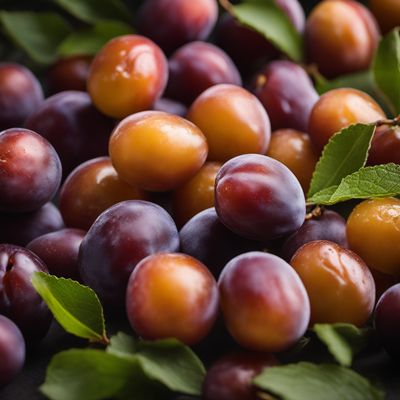
Ingredient
Plumcots
The Perfect Blend: Exploring the Unique Delights of Plumcots
Plumcots, also known as pluots, are a cross between plums and apricots. They have a smooth, firm skin that ranges in color from deep purple to golden yellow, depending on the variety. The flesh is juicy and succulent, with a texture that is both firm and tender. Plumcots have a sweet and tangy flavor, with hints of both plums and apricots. They are a delightful balance of sweetness and acidity, making them a versatile ingredient in both sweet and savory dishes.
Origins and history
Plumcots were first developed in the late 19th century by horticulturist Luther Burbank. He crossed plums and apricots to create a fruit that combined the best qualities of both. Since then, plumcots have gained popularity for their unique flavor and have become a beloved fruit in many cuisines around the world.
Nutritional information
Plumcots are a nutritious fruit, rich in vitamins A and C, as well as dietary fiber. They are also low in calories, making them a healthy choice for snacking or incorporating into various dishes.
Allergens
There are no known allergens associated with plumcots.
How to select
When selecting plumcots, look for fruits that are plump, with a smooth and unblemished skin. Avoid fruits that are overly soft or have bruised spots. The color of the skin will vary depending on the variety, but it should be vibrant and even.
Storage recommendations
To maintain the freshness and quality of plumcots, store them at room temperature until they are ripe. Once ripe, they can be stored in the refrigerator for up to a week. It is best to consume them within a few days for the best flavor.
How to produce
Plumcots are typically produced through controlled cross-pollination by horticulturists. However, if you have the space and resources, you can try growing your own plumcot tree by planting a plumcot seed or grafting a plumcot branch onto a compatible rootstock.
Preparation tips
Plumcots can be enjoyed fresh as a snack or incorporated into a variety of dishes. They can be sliced and added to salads, used in jams or preserves, or baked into pies and tarts. When preparing plumcots, simply wash them, remove the pit, and slice or dice as desired. The skin is edible and adds a beautiful color to dishes, but you can also peel it if preferred.
Culinary uses
Plumcots are a versatile ingredient in both sweet and savory dishes. They can be used in fruit salads, smoothies, jams, and desserts like pies, tarts, and cobblers. In savory dishes, they can be grilled and served alongside meats, or used in chutneys and sauces to add a touch of sweetness and acidity.
Availability
Plumcots are commonly available in regions with suitable climates for growing stone fruits, such as the United States, particularly California, as well as Mediterranean countries like Spain and Italy.
More ingredients from this category » Browse all

Beach plums
The Hidden Gems of the Shoreline: Exploring the Delights of Beach Plums

Mirabelles
The Golden Gems of Summer

Klamath plums
The Jewel of Klamath

Prunus Nadia®
The Exquisite Fusion of Sweetness and Tartness: Prunus Nadia®

Chickasaw plums
The Sweet Gems of the South

Gages
The Sweet and Succulent Delight: Exploring the World of Gages

Chinese jujubes
The Ancient Fruit: Chinese Jujubes

Cherry plums
The Sweet and Tangy Delight: Exploring the World of Cherry Plums

American plums
The Sweet and Tart Delight: Exploring the World of American Plums

Damsons
The Prized Gems of the Plum Family

Sloes
The Bitter-Sweet Berry

Plums
The Juicy Gems